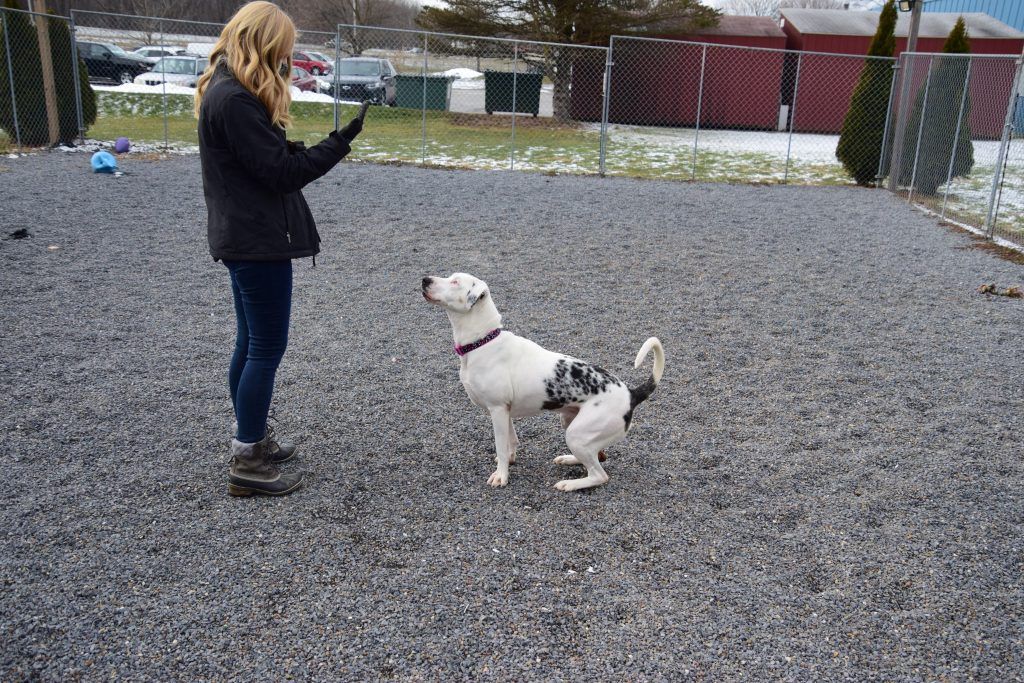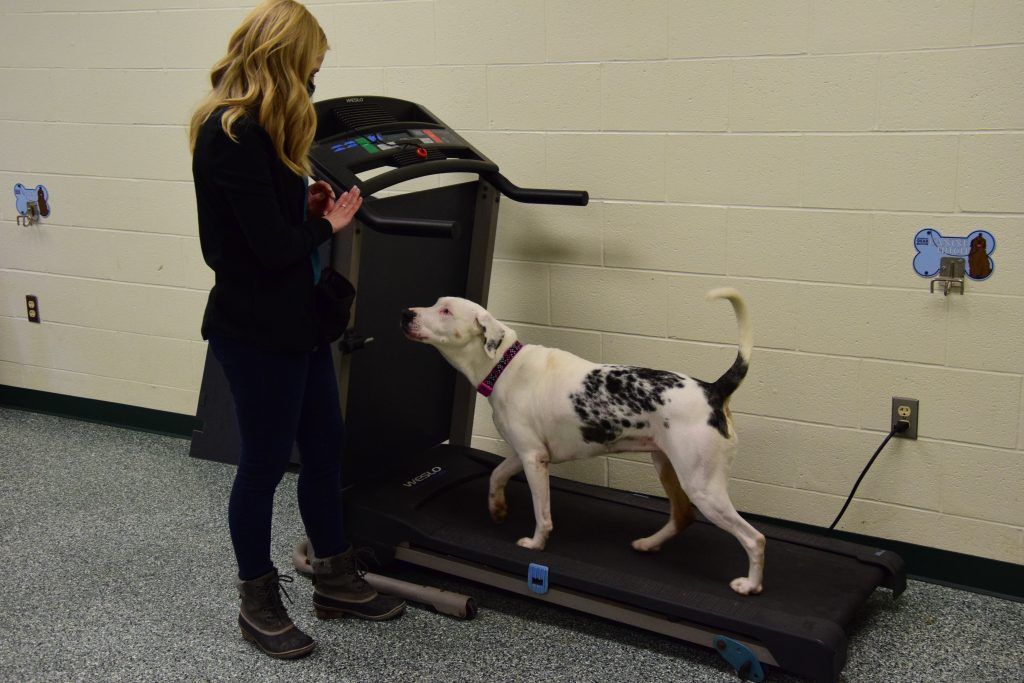WILLIAMSPORT – Full of energy and always ready to play, 2-year-old Pixie appears to be the same as the other 25 dogs looking for forever homes at the Lycoming County SPCA. There’s one notable difference, though – Pixie is deaf.
“She is a double merle, and deafness is common” in those dogs, says Rochelle (Smith) Scudder, an SPCA volunteer and Pixie’s principal trainer.
Merle is a gene that causes changes in pigment cells in an animal’s eyes, inner ears, skin and fur. It can create patches of color in fur, and blue or unusually colored eyes. A double merle has two dominant merle genes, which usually results in a predominately white coat and degrees of blindness and deafness.
“Pixie doesn’t respond to dog whistles or snapping your fingers by her ear. She is completely deaf,” Scudder said. “Often, double merles do have compromised vision; she has a starburst pupil. I’m not sure how she sees the world, but she can see.”
Sign language
But Pixie doesn’t let her inability to hear hold her back, and she has a pair of patient instructors helping her learn a new way to communicate – through sign language and hand gestures.
Scudder, who developed a “vocabulary” of gestures based on American Sign Language, enlisted Hughesville High School student Bailey Derrick, 15, to help Pixie learn basic commands.

“I don’t think of myself as an animal trainer,” Scudder said. “I feel like my approach and my skill is more of being an interpreter.”
She did work for an animal trainer, though. After graduating from Williamsport Area High School in 2000 and then from Penn State University, Scudder pursued a career as a professional actress in live theatre.
“Prior to COVID, I worked for a theatrical animal trainer in New York City — William Berloni Theatrical Animals. I worked with him over six years, and I’ve known him for longer than that.”
Scudder said she met Berloni when she was cast in the second national tour of “Legally Blonde,” which was performed at the Community Arts Center in 2011 and in multiple cities across the U.S. and Canada.
He rescued and trained dogs for that show.
“I understudied two roles that worked with the dogs, so I learned how to safely work with the dogs on stage,” Scudder said.
‘Make it fun’
A few years later, she decided to work with Berloni himself.
“It changed the trajectory of my entire career,” she said, “and taught me a lot about working with animals and people.
“His method is, ‘Make it fun, make it a place they want to be.’”

That perspective has been “the baseline” for her work with Pixie, and Bailey.
Scudder returned to her hometown in July 2020 and began volunteering at the SPCA two months later.
“I was tasked with giving (Pixie) some special attention, one-on-one work with basic obedience. I was up to a challenge, and I spent a decent amount of time with her every day,” she said.
Quick learner
Scudder taught the dog hand signals, but Pixie was “a very quick learner. She quickly outpaced what I thought I could teach her.”
She reached out to Berloni, who recommended Scudder contact one of his friends, a woman named Connie Bombaci, who trains deaf dogs.
“She has been an amazing resource,” Scudder said of Bombaci, who has written a book on the subject and spoken with Scudder by phone and social media.
Scudder then shifted from teaching Pixie traditional hand signals to using ASL, “which is a language I do not know.”
In the months that followed, she began adding words and phrases to Pixie’s vocabulary.
“I realized that whenever you train any animal, especially a smart one, you have to work hard to stay ahead, or they get bored,” she said.
For that reason, and because the primary goal is to teach Pixie to understand and obey commands given by anyone – such as members of her forever family – Scudder asked other volunteers and staff members if they wanted to “learn Pixie’s language.”
Bailey was the first one to come forward.
“She wanted to dive in,” Scudder said. “It’s really wonderful that Bailey was the first volunteer. She has the right calm and patient attitude, and she has the right energy in working with dogs.
“I wanted to demonstrate that anyone who took the time to learn Pixie’s language can work with her. Pixie can follow commands as well as a hearing dog can,” she just has to have them delivered in a different way.
A special love
Bailey stepped up because she had a special love for Pixie.
“Pixie was one of my favorites. She was always really nice and loved kids,” Bailey said, adding that the canine is a Catahoula leopard dog. “I think she is a herding breed.”
The breed is named for the area where it originated, Catahoula Parish, Louisiana, and the leopard refers to the pattern of splotches that often – but not always – appear on the animals’ skin and fur. Catahoula leopard dogs were bred to herd wild cattle and hogs.
“Pixie didn’t act like she was deaf,” said Bailey, who has volunteered at the shelter with her mom, Dana, and twin sister, Bryn, for about a year.
The girls wanted a dog, but Dana thought helping at the rescue would be a good way to first show them the level of work involved with owning a pet.
Bailey said she volunteered to aid Scudder in order to “help Pixie respond to other people. I do hand signals with her and basic commands. And I help her with running on the treadmill.”
Yes, you read that right. Pixie works off her excess energy by running on a treadmill that was donated to the shelter.
“I don’t know sign language, but I learned the commands (such as) sit, stay, lay down, come,” Bailey said. “She is the first dog I’ve worked with at the SPCA that’s special needs.”
Finding a forever home
Scudder teaches the young dog and Bailey at the same time.
“I taught her Pixie’s signals, how to make sure to have her attention first and how to make a correction if Pixie did not do what she asked,” Scudder said.
With a dog that can hear, “you might raise your voice, but that doesn’t work with Pixie. Once Pixie learned how to communicate with humans, she desired it,” she added.
Usually, Pixie’s eyes are trained on the person who is giving her a command, but, like any dog, sometimes she has other things on her mind.
“I know she understands me,” Scudder said, “but if Pixie doesn’t do as I ask and she ignores me, I can leave the room. When she’s calm and polite, I’ll come back in.
“I teach that to Bailey because, ultimately, the goal is that Pixie becomes a polite pet,” Scudder said, one that can find the right family that will love her forever.



